We’ve covered how I got the idea for my homemade pizza oven and how I designed and built it. Now it’s time to cover how it works.
A little experiment I’m working on. I'll test it tomorrow night and blog the results. Could be a game-changer. pic.twitter.com/q4ZnQ4FXO6
— Chad Chandler (@chad_chandler) May 20, 2014
A few days before I planned to make the inaugural pizza, I mixed my pizza dough. While it was cold-fermenting, I decided to do a burn-in of the oven to see how hot it got. I wanted to test the airflow and heat levels, but I also wanted to eliminate any dust or residue that might still be present from the building stage.
I lit a chimney full of charcoal. Once the coals were ashed over, I poured them into an even layer at the bottom of my grill (on top of some unlit coals) with the bottom vent fully open. This is what I used to preheat the oven. I set the lid on the grill and left it alone for 30 minutes.
My fear with this project has been that the restricted airflow would choke the fire. When I came out and saw that the thermometer measured 600°, I was pleased to say the least.
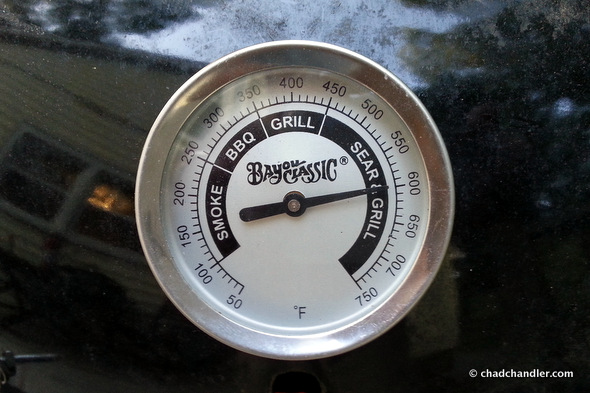
The charcoal is there to provide a base temperature. The temperature spikes necessary to cook at brick oven temperatures come from burning wood. So I slid the lid off a little in the back and dropped in two small pieces of oak. It took a few minutes for the wood to catch fire, but when it did, the flame danced up the rear of the grill and stretched along the ceiling toward the vent.
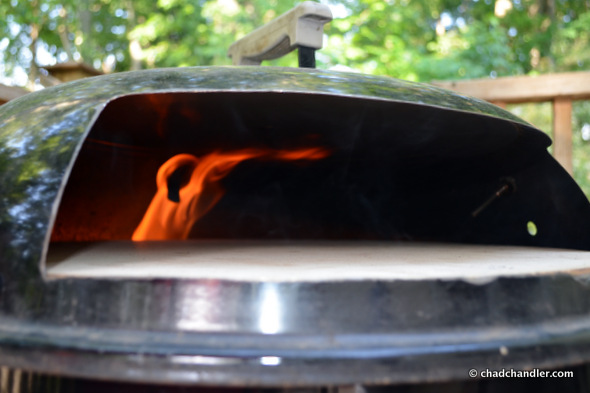
Within ten minutes, the thermometer spiked to 700° and stayed there for around 15 minutes. That should be enough time to prepare a couple of pies between refuelings. I should add that the thermometer is measuring the coldest part of the oven. It’s much hotter in the back near the flame.
Finally, it was time to actually make some pizzas. I decided to make three pies—a traditional Margherita, a white pie, and a cheese and salami pizza. I’ll blog the recipes when I’ve had time to properly work them out. This round of baking was meant to test the oven set-up more than the recipes.
The first pie in was the salami pizza. I figured it would be the most forgiving. The dough wasn’t fully relaxed, so I had some trouble stretching it. I carefully slid the pizza onto the stone and rotated it a little every 20 or so seconds until it was finished cooking. It cooked in less than two minutes. That means that the oven is burning hot enough for true Neapolitan pies.
Unfortunately, I left a little too much flour and cornmeal on the bottom of the pie and it burned, giving the crust a hint of bitterness.

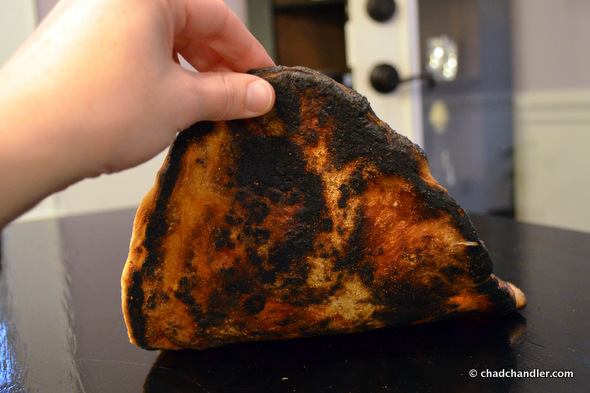
Next up was the white pie. I had a better sense of what I was doing with this pie, but I didn’t stretch the dough as thin as I wanted. I was careful to only use enough flour to keep the dough from sticking to the pizza peel and the crust came out better.
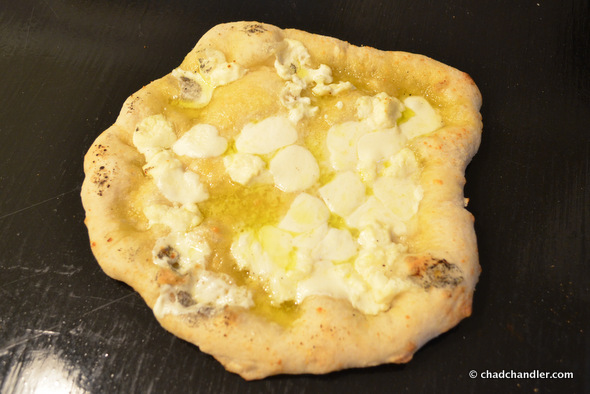
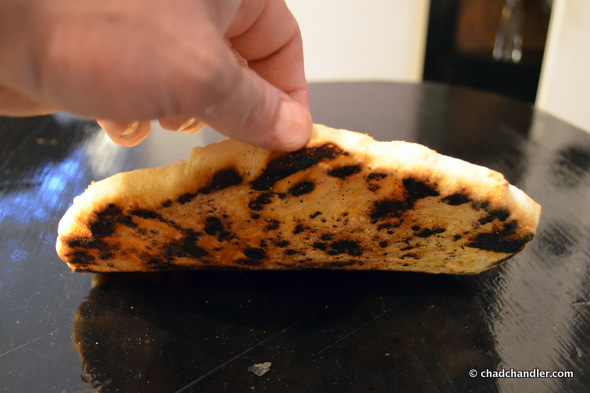
Finally came the Margherita. It’s the wife’s favorite pizza, so she made it. We realized that the stone was too hot and the tops and the bottoms of the pies weren’t heating evenly. I’ll have to play around with the amount of charcoal necessary to preheat the stone. We decided to cook this pie in a pizza tray and it worked out well.
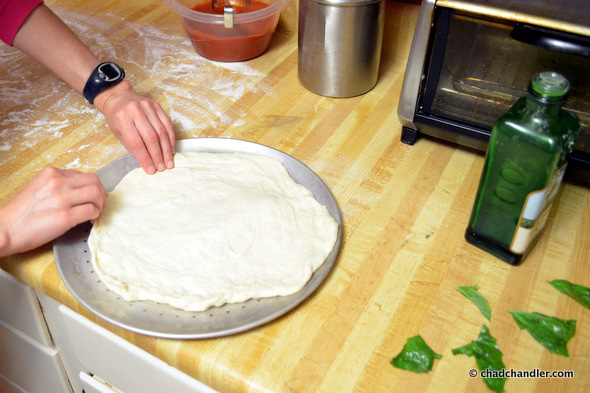
This ended up being a very simple solution. Since we didn’t have to worry about the dough sticking to the pizza peel, we didn’t have to use any excess flour or corn meal. And the tray acted as a nice buffer between the dough and the stone, allowing the dough to rise quickly without scorching.
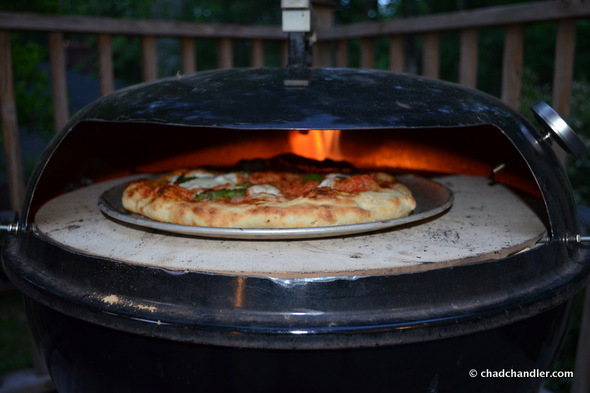
This one came out great. I took a Vine of the top of the pizza as it came out of the oven—highlighting the amazing bubbling, sizzle, and steam—but I lost it when it failed to upload. So, sadly, there’s no good picture of the top of the pizza. But the bottom was almost perfect.
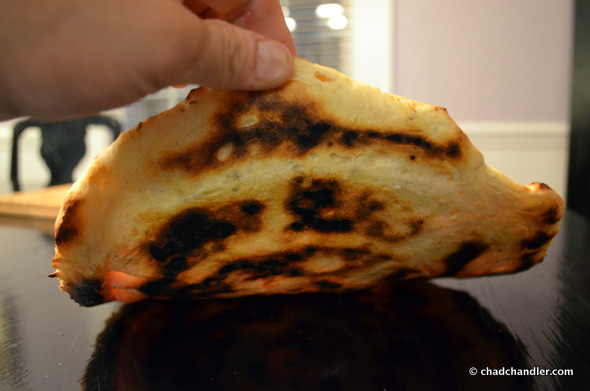
This was fun. It’ll take some time for me to learn how to get my crust to stretch, rise, and char just the way I like it, but that’s an issue with technique rather than tools.
I don’t think it’s too early to call my modified kettle wood-fired pizza oven a success. These pies all cooked in under 150 seconds each and we got a good rise out of the dough.
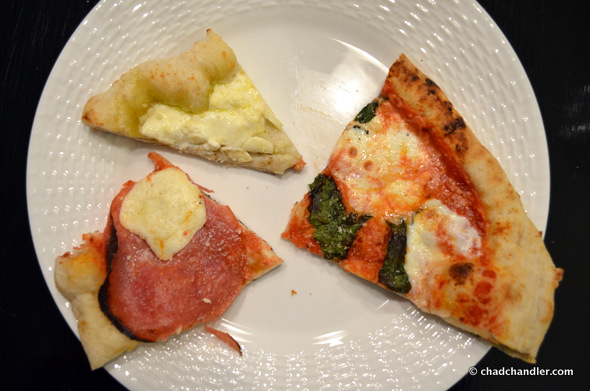
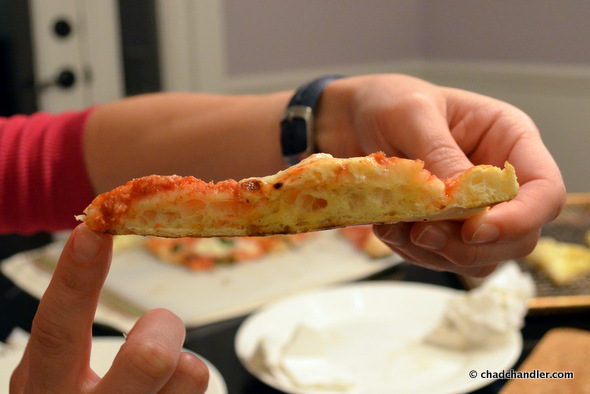
The only things left to do are to experiment, take notes, and quantify how many charcoal briquets and pieces of oak are necessary to balance the heat in the oven. That’s some trial and error that I’m really looking forward to.
I really like the idea of cooking the pies in trays on the stone. If I can hammer a slight dimple into the center of the pan, it would allow me to rotate a pizza in the oven like it’s on a lazy Susan. That would make the baking process much easier.
In a few months, we should be cooking perfect pizzas that cost less and taste better than anything we can buy in town. What do you think?
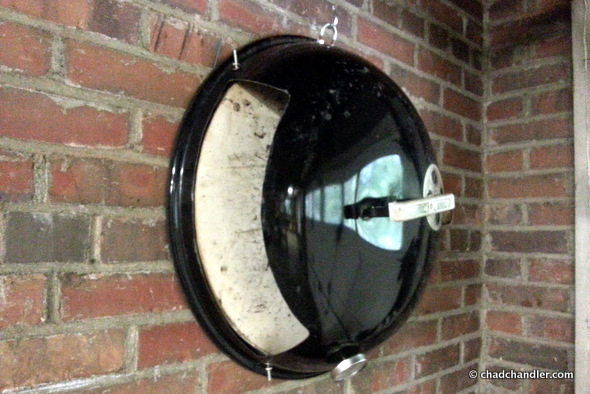
UPDATE 1: Homemade NY-style pizza
UPDATE 2: I’ve mastered cooking in this thing







Pingback: Modified Kettle Wood-Fired Pizza Oven, Part 2 | Chad Chandler
Beautiful. These pizzas look so good! I’d say this undertaking has been a resounding success. Now if you could only mass produce your design…………………
I’ve had the same idea, and posted on Craigslist for a used lid the way you did.
One modification I might try, is to add another pizza stone inside the top part of the kettle lid 2-3 inches above the pizza. That way the top of the pizza cooks faster because of more radiant heat. I kind of borrowed that idea from another pizza cooking tool, called the “Mighty Pizza Oven”.
Pingback: Homemade NY-Style Pizza | Chad Chandler
Thanks for blogging this! I am planning to do my own build soon.
One question please: Are you still cooking the pizza in a pan on top of the stone? I had thought directly on the stone would have produced a better crust so it was very interesting to read your pan method.
The hollow stone gets too hot to cook evenly. In a real pizza oven, the stone acts as a heat sink and doesn’t get quite as hot as this kiln shelf does. That allows for more even cooking. With this build, the bottom cooks faster than the top (unless you really have the fire going). I found that the pan/screen provides a little extra time to allow the top to cook before the bottom starts to burn. You can always toss the pizza onto the stone for a second to get that leopard spotting.
have you tried cooking anything else with this.. bread or I was thinking of possibly finishing off my steaks after searing them b/c of the high heat, like the restaurants do.
thanks.. this looks awesome
Thank you for these posts! I just finished my version recently. Did a test batch last night and oddly it got too hot and burned the bell out of the bottom of my first pie. I think I used too much charcoal, and am using hardwood “cowboy” chunks. What did you use for charcoal? I’m thinking I’ll use regular briquettes next time as they don’t burn as hot.